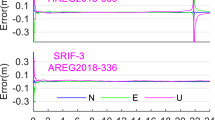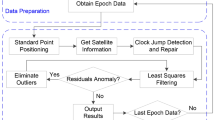Abstract
We present the new MAP3 algorithms to perform static precise point positioning (PPP) from multifrequency and multisystem GNSS observations. MAP3 represents a two-step strategy in which the least squares theory is applied twice to estimate smoothed pseudo-distances, initial phase ambiguities, and slant ionospheric delay first, and the absolute receiver position and its clock offset in a second adjustment. Unlike the classic PPP technique, in our new approach, the ionospheric-free linear combination is not used. The combination of signals from different satellite systems is accomplished by taking into account the receiver inter-system bias. MAP3 has been implemented in MATLAB and integrated within a complete PPP software developed on site and named PCube. We test the MAP3 performance numerically and contrast it with other external PPP programs. In general, MAP3 positioning accuracy with low-noise GPS dual-frequency observations is about 2.5 cm in 2-h observation periods, 1 cm in 10 h, and 7 mm after 1 day. This means an improvement in the accuracy in short observation periods of at least 7 mm with respect to the other PPP programs. The MAP3 convergence time is also analyzed and some results obtained from real triple-frequency GPS and GIOVE observations are presented.








Similar content being viewed by others
References
Bisnath S, Gao Y (2007) Current state of precise point positioning and future prospects and limitations. In: Proceeding of IUGG 24th general assembly, 2–13 July 2007, Perugia, Italy
Crisci M, Hollreiser M, Falcone M, Colina M, Giraud J (2007) GIOVE mission sensor station performance characterization: overview of the results. In: Proceedings of the 20th international technical meeting of the satellite division of the institute of navigation (ION GNSS 2007), Fort Worth, TX, September 2007, pp 1028–1041
Dach U, Hugentobler U, Fridez R, Meindl P (2007) Bernese GPS software version 5.0. Astronomical Institute University of Bern
De Bakker PF, Tiberius C, van der Marel H, van Bree RJP (2012) Short and zero baseline analysis of GPS L1 C/A, L5Q, GIOVE E1B, and E5aQ signals. GPS Solut 16(1):53–64. doi:10.1007/s10291-011-0202-3
De Lacy C, Gil AJ, Rodriguez-Caderot G, Moreno B (2008) A method to estimate the ionospheric bias by using the new GNSS frequencies: an analysis of its theoretical accuracy in a PPP context. Física de la Tierra 20:133–150
Dow JM, Neilan RE, Rizos C (2009) The international GNSS service in a changing landscape of global navigation satellite systems. J Geod 83:191–198
Euler HJ, Goad CC (1991) On optimal filtering of GPS dual frequency observations without using orbit information. Bull Geod 65:130–143
Ge M, Gendt G, Rothacher M (2006) Integer ambiguity resolution for precise point positioning. In: Proceeding VI Hotine-Marussi symposium of theoretical and computational Geodesy
Ge M, Gendt G, Rothacher M, Shi C, Liu J (2008) Resolution of GPS carrier-phase ambiguities in precise point positioning (PPP) with daily observations. J Geod 82:389–399
Hopfield HS (1972) Tropospheric range error parameters: further studies. The Johns Hopkins University—Applied Physics Laboratory, Baltimore MD
ICD-GPS-200 (2000) Global positioning system wing (GPSW) systems engineering and integrations. Interface control document. IRN-200C-004
Juan JM, Hernández-Pajares M, Sanz J et al (2012) Enhanced precise point positioning for GNSS users. IEEE Trans Geos Rem Sen 50(10):4213–4222
Kouba J, Héroux P (2001) Precise point positioning using IGS orbit and clock products. GPS Solut 5(2):12–28
Moreno B, Radicella S, De Lacy C, Herráiz M, Rodríguez-Caderot G (2011) On the effects of the ionospheric disturbances on precise point positioning at equatorial latitudes. GPS Solut 15(4):381–390
Petit G, Luzum B (2010) IERS Technical note No. 36. Frankfurt am Main: Verlag des Bundesamts für Kartographie und Geodäsie, 2010. 179 pp. ISBN 3-89888-989-6
Píriz R, García AM, Tobías G et al (2008) GNSS interoperability: offset between reference time scales and timing biases BIPM and IOP publishing ltd. Metrologia 45:87–102
Saastamoinen J (1973) Contribution to the theory of atmospheric refraction. Bull Geod 105(1):279–298
Schoenemann E, Becker M, Springer T (2011) A new approach for GNSS Analysis in a multi-GNSS and multi-signal environment. J Geodetic Sci 1(3):204–214
Simsky A, Mertens D, Sleewaegen JM, Hollreiser M, Crisci M (2008) Experimental results for the multipath performance of Galileo signals transmitted by GIOVE-A satellite. Int J Navig Obs Article ID 416380. doi:10.1155/2008/41638
Tobías G, Hidalgo I, Mozo A et al (2009) Building Galileo navigation system: two years of GIOVE-M experimentation. In: Proceeding ION GNSS-2009, The Institute of Navigation, Savannah, Georgia, Sept, pp 2967–2979
Wu J, Wu C, Hajj G, Bertiger W, Lichtenr S (1993) Effects of antenna orientation on GPS carrier phase. Manuscripta Geodaetica 18:1647–1660
Zandbergen R, Navarro D (2006) Specification of Galileo and GIOVE space segment properties relevant for satellite laser ranging. Tech. Note, European Space Agency
Acknowledgments
The research was supported by the research projects New Algorithms for the Future Multifrequency GNSS System (Ref. AYA2008-02948) and Application of the Satellite Radar Interferometry and the Global Navigation Satellite Systems to the control of distortions in the Baetic Cordillera (Ref. AYA2010-15501), funded by the Spanish government. The authors would like to thank Francisco Gonzalez for his contribution in the development of PCube, IGS for providing GPS observations and satellite products, ESA for providing GESS observations and GPC products, and the online PPP programs CSRS-PPP, magicGNSS, and APPS for their valuable services. We also appreciate the reviewers’ suggestions and improvements to this manuscript.
Author information
Authors and Affiliations
Corresponding author
Rights and permissions
About this article
Cite this article
Moreno Monge, B., Rodríguez-Caderot, G. & de Lacy, M.C. Multifrequency algorithms for precise point positioning: MAP3. GPS Solut 18, 355–364 (2014). https://doi.org/10.1007/s10291-013-0335-7
Received:
Accepted:
Published:
Issue Date:
DOI: https://doi.org/10.1007/s10291-013-0335-7




